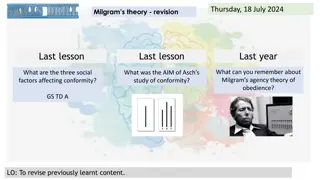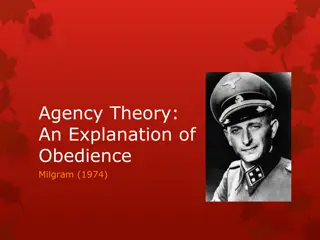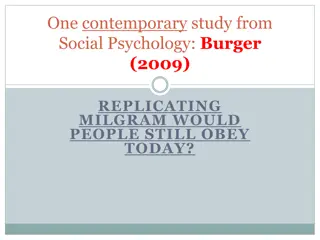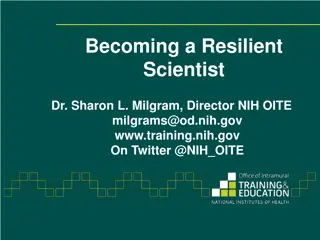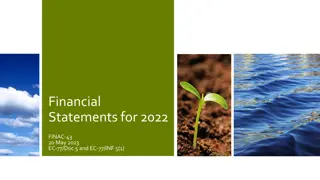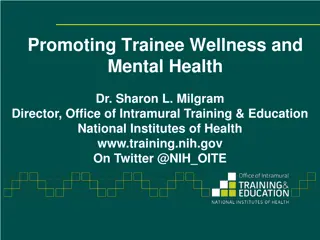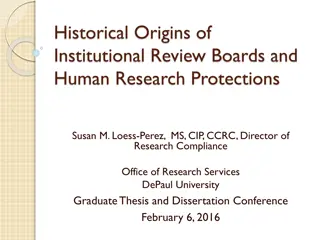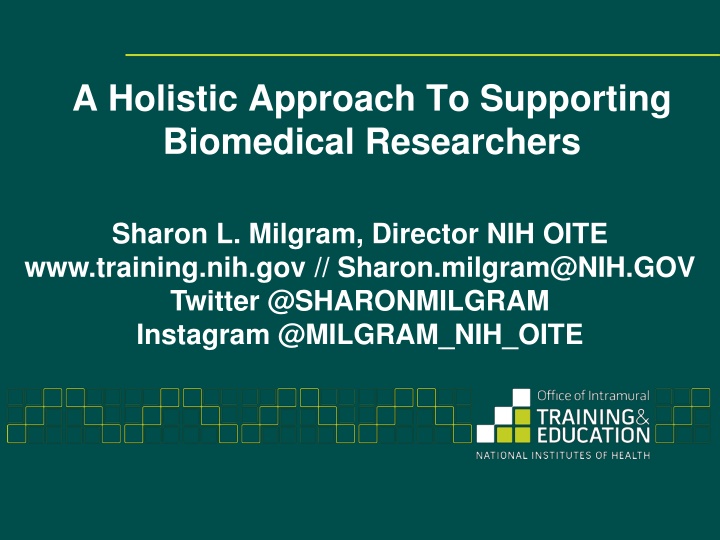
Supporting Biomedical Researchers Holistically for Well-Being
Explore a holistic approach to supporting biomedical researchers for well-being, focusing on protective factors, important questions, barriers, and designing programs specific to the community. Discover valuable insights to enhance researchers' overall wellness in their demanding field.
Download Presentation

Please find below an Image/Link to download the presentation.
The content on the website is provided AS IS for your information and personal use only. It may not be sold, licensed, or shared on other websites without obtaining consent from the author. If you encounter any issues during the download, it is possible that the publisher has removed the file from their server.
You are allowed to download the files provided on this website for personal or commercial use, subject to the condition that they are used lawfully. All files are the property of their respective owners.
The content on the website is provided AS IS for your information and personal use only. It may not be sold, licensed, or shared on other websites without obtaining consent from the author.
E N D
Presentation Transcript
A Holistic Approach To Supporting Biomedical Researchers Sharon L. Milgram, Director NIH OITE www.training.nih.gov // Sharon.milgram@NIH.GOV Twitter @SHARONMILGRAM Instagram @MILGRAM_NIH_OITE
Protective Factors The development and use of positive coping styles Connection and support Time to take care of yourself, attend to hobbies, rest and recharge A sense of financial stability Important to appreciate that program directors and PIs play a major role in helping trainees in all four of these areas At the institutional and research group level
Important Question For Each Of Us [If money was not an issue], what would a comprehensive well being program for scientists look like?
It Would See The Whole Person Everyone who is integral to the success of the system students, postdocs and other trainees faculty support staff People first and scientists second (even if we prefer not to acknowledge that) many trainees are emerging adults, and all are emerging scientists some PIs are emerging managers and leaders many (most?) of us have not had enough training in self- and relationship management nobody wants to come to work and leave a part of who they are at the door/gate what happens outside of work does not stay outside of work
Within A Difficult System What are some of the barriers that keep you from using potentially helpful resources? (%) N=334 Fear/Shame No time Lack resources or knowledge Too exhausted/defeated Feel the need to handle by self Negative self-talk Other (e.g., Mentor) Denial of the problem Stereotypes/cultural differences Mental health conditions (ADHD, PSTD, etc) % of responses 44.9% 12.9% 8.7% 8.4% 6.9% 5.7% 4.5% 3.3% 1.8% 1.8% Bad previous experience 1.2%
And Would. Be designed specifically for the community and account for different lived experiences and views of achieving well being Be grounded in models that resonate with research-oriented data driven people Have multiple entry points to reduces barriers to accessing resources and taking time for wellness Provide consistent and on-going training for all stakeholders Have the support of important exemplars and institutional leaders who back the program with their time and by opening their pocketbook Put wellness into the broader context of student/staff development
The Broader Context Affinity groups DEIA programs Allyship training Resilience Well-Being Mental Health Need to work in all four areas Civility Programs Mentor Training Professional development Career development Support for diverse careers
Our Window of Tolerance Reactive zone The zone where we function most effectively respond productively to stress easily find our creative problem-solving self address interpersonal issues calmly and respectfully acknowledge mistakes and seek to repair relationships Give up and ignore zone Siegel, D.J. (2012). The Developing Mind: How Relationships and the Brain Interact to Shape Who We Are. New York, USA: Guilford Press.
Two Consistent Messages To Do Well, We Have To Be Well To Treat Others Well, We Have To Be Well Ourselves
OITE Wellness and Resilience Program Workshops and series Becoming a Resilient Scientist series (2-3 times per year; just started a cycle) monthly mental health webinars and small group discussions Small group resilience/wellness activities meditation and journaling skills groups (on-going) resilience skills and support groups (new topics monthly) Thriving Thursday or Wellness Wednesday brown bag lunches monthly wellness events (laughter yoga, Zumba, Improv, painting) affinity group lunches and social activities Individual wellness advising and consultations with PIs and research staff Referrals to mental health providers in the community finding therapists who understand the research culture and specific issues for trainees is key https://www.training.nih.gov/wellness
Lessons Learned From 7+ Years It takes time (and a lot of frustration tolerance) to gain traction People will come when they come but you can make it easier for them to come and harder for them to avoid you It takes constant regular messaging from people who matter Well intentioned does not always mean well-skilled Trainee groups do some of the work for you (with caveats) And from the pandemic trainees outside NIH ask to attend some of our discussion-based programs (win-win)
OITE Resilient Scientist Series Mentoring Feedback resilience assertiveness skills Our Our feelings Summer 2020 Fall 2020 Winter 2021 (RTP) Summer 2021 X2 Fall 2021 Spring 2022 thoughts How we take care of ourself
Resilient Scientist Series Goals Provide specific tools for wellness and resilience Normalize challenges that trainees face Establish a common language for on-going dialogue Highlight protective factors and risk factors for student mental health and well-being Decrease stigma around using resources, tending to our (mental) health, and reaching out for support Explore how individual experience shapes attitudes and behaviors Support discussion of how power dynamics, the culture of science, bias, and structural isms potentially drive an individual s negative thoughts and feelings Model the vulnerability needed to make change Help people avoid, deal with, or get out of toxic research groups
RSS Training Program (RTP) Trained colleagues at NIH and on ~70 campuses to facilitate small group discussions following each webinar using a materials developed in the OITE Two or three-week cycle of webinar, groups, de-brief/prep Satisfaction surveys at each step + in-depth assessment Used multiple validated tools to assess: resilience anxiety, depression, stress subjective and psychological well-being self-awareness shift and persist self-efficacy
A Bit About the RTP1 Audience Gender Race/Ethnicity N Percent N Percent No Response (skipped) Asian Black or African American Hispanic/Latino(a) Native Hawaiian or Pacific Islander White/Caucasian Biracial/Multiracial Other Rather not answer 70 53 48 17 12.9 11.7 6 285 107 5 7 1.5 69.2 26 1.2 1.7 Female Male Other Transgender Rather not answer 2 186 36 5 8 .5 45.1 9.7 1.2 1.9 2 0.5 Age N Percent Skipped/No response 18 - 24 25 34 35 - 44 45 - 54 55 - 64 65 or older Rather not answer 4 98 252 40 7 4 1 6 1 23.8 61.2 9.7 1.7 1 0.2 1.5 Number of Sessions Attended # of sessions N Percent 1 2 3 4 5 6 31 17 34 47 51 232 7.5 4.1 8.3 11.4 12.4 56.3 N=412 participants who completed the post-series survey (~53%)
Series Evaluation: At a Glance Race/ Ethnicity Training level Results Main Findings* Gender 87.7% of traineesfound the series to be excellent to very good (M=4.41) Overall Rating NS p=.28 NS p=.21 NS p=.94 94.4% oftrainees would recommend the series to a friend or a colleague (M=4.68) Would Recommend NS p=.99 NS p=.11 NS p=.66 NS p=.13 NS p=.24 NS p=.40 92.9% oftraineesfound the series valuable (M=4.58) Valuable There is a statistically significant increase in self- reported knowledge of how to become a more resilient scientist after the series. NS p=.69 NS p=.11 NS p=.85 Increase in Knowledge (t(403)=41.19, p<.00, Mchange=2.411, SD=1.18) (Mpre=1.7, SD =1.0//Mpost = 4.11; SD = 0.67) *All responses are on 5-point Likert scale, N=412 (+/-)
Repetition Matters Attended less than half Attended more than half M=4.51 (SD=.68) p-value & effect size (Cohen s d) Gained Important Skills that Help @ Work/Home M=3.96 (SD=1.00) p<.001 d=.73 (moderate-large) p<.001 d=.55 (moderate) Manage Conflicts Better M=3.70 (SD=.92) M=4.14 (SD=.77) Manage Stress Better M=3.74 (SD=1.0) M=3.85 (SD=.93) M=4.15 (SD=.78) M=4.25 (SD=.76) p<.001 d=.50 (moderate) p<.001 d=.50 (moderate) Became More Resilient After Participation Are Becoming Better Scientists M=3.6 (SD=.99) M=3.85 (SD=.83) p=.023 d=.29 (small)
Paired Data (Pre/Post) 217 trainees completed both pre-and post-series survey matched via guided-unique identifier Gender Education Status Females 76.5% Undergraduate 7.8% Males 20.7% Masters 2.8% Other/Declined to Answer 2.8% PhD or Doctoral student 72.8% Professional degree 1.4% Professional degree 1.4% Postdoc 10.6% Number of Webinars Attended # of sessions Other (i.e., Postbac) 4.6% N Percent 1 2 3 4 5 6 7 7 22 25 24 132 3.2 3.2 10.1 11.5 11.1 60.8
Conclusions I Participation in the Resilient Scientists Series has a positive impact on the trainees (over a long period of time) Participation in the program increases: overall resilience self-efficacy self-awareness ability to shift and persist While decreasing: anxiety (non-clinical) depression (non-clinical) perceived stress presenteeism
Conclusions II These factors likely to contribute to the perception (if not actual change) that they are becoming a better scientist and are dealing with stress and conflict better Those who attend more sessions have better outcomes There are differences based on gender and race/ethnicity that need careful evaluation and further discussion Caveats: we cannot rule out motivation as a factor as most attended all the sessions in the paired-sample data. we are unable to distinguish the impact of the webinars alone vs. webinars + small groups
Data on RTP and Minority Trainees (post-participation data) Non-white trainees felt that they have become more resilient compared to white participants. White M= 4.04 (SD= 0.82) Non-White M=4.30 (SD=0.78) t(394)=3.3, p=.001 N=186 N=210 Cohen s d= .79 Non-white trainees felt that they have become better scientist compared to white participants. White M= 3.63 (SD= 0.84) Non-White M=3.96 (SD=0.86) t(396)=3.8, p<.001 N=186 N=212 Cohen s d= .85 * Reponses on 5-pt Likert scale
Some Things To Keep In Mind This is no one-hit wonder needs to be part of a larger program Some frequent comments are I wish I heard this sooner this should be mandatory it takes too much time I wanted to come but worried about my PI Gender gap in participation will likely slow culture change Online format has some limitations AND presents some opportunities some students attended virtual groups at other institutions negates problems of small numbers allows people to leverage strengths allows the pooling of resources for extender activities
The Most Important Point This series will not be enough in the absence of broader culture change AND it is irresponsible to ask the students to weather environments that we know are unwelcoming and unsupportive
If We Line Up PIs, We Will Find Tor-mentors unkind mentors absent mentors good enough mentors good mentors great mentors
OITE Climate Assessment 81 questions (+/-) to assess climate and mentoring ends with an optional 9-item questionnaire to assess work stress Total of 346 participants participated since 2020 when we moved to on-line at the start of the pandemic includes a major unbiased population Thanks to Anna Han
Research Group Environment Strongly Agree % Agree % Slightly agree % Slightly disagree % Disagree % Strongly Disagree % My research group has a collegial atmosphere. I have witnessed someone being bullied or harassed in my research group. Someone in my research group has bullied or harassed me. 50.3 37.1 7.6 0.9 2.6 1.5 5.0 5.0 5.3 3.8 23.6 57.2 4.7 1.6 3.7 5.3 18.9 65.8 Witnessed = 15% Experienced = 10% Environment not collegial = 5%
About My PI Strongly Agree % Agree % Slightly agree % Slightly disagree % 2.1 Disagree % Strongly Disagree % 73.7 1.2 1.2 3.3 18.5 My PI yells and demeans individuals when upset. My PI has threatened me in some way (e.g., termination, recommendation letters or lose authorship, etc). I have witnessed my PI bullying or harassing someone in my research group. My PI has bullied or harassed me. 2.1 1.5 1.8 3.3 9.3 82.0 1.4 0.9 2.7 1.8 9.0 84.2 0.9 0.6 1.2 2.1 9.1 86.1 0.3 0.6 1.8 1.8 11.2 84.2 My PI makes inappropriate comments and/or jokes that make me uncomfortable.
Sexual Harassment and Discrimination Strongly Agree % Agree % Slightly agree % Slightly disagree % 1.6 Disagree % Strongly Disagree % 0.4 75.1 20.2 2.3 0.4 My PI is is supportive of people of all backgrounds, races, cultures, genders, sexual orientations, countries, and disabilities, etc. 70.6 23.8 3.2 0.3 1.5 0.6 My research group members are supportive of people of all backgrounds, races, cultures, genders, sexual orientations, countries, and disabilities, etc. Someone in my group has inappropriately touched me. My PI has inappropriately touched me. - 0.3 0.6 0.6 10.4 88.1 0.6 - 0.6 - 7.6 91.2
Some Important Points 5.6% of survey participants met the threshold for occupational depression (not clinical as it is a modified version) many (but not all) report hostile climate (lab, PI, or both) When the PI bullies and harasses individuals, members of the group are more likely to bully/harass each other 50% of individuals who report being harassed by the PI also report harassment by others; the reverse does not hold Engagement of the PI in resolving conflict in a calm manner is a significant negative predictor of bullying/harassment in research groups (p<0.001) accounts for 26% of the variance in witnessing and 34% in experiencing bullying/harassment within their research group
Some Thoughts We need a more robust training focused on many topics promoting DEIA, self- and relationship- management, mentoring, difficult conversations, change management, mental health first aide, dealing with conflict, etc. a focus on helping PIs resolve conflicts within their group and helping trainees/staff resolve conflict themselves is likely to pay substantial dividends For many, training is insufficient without coaching this is costly; training internal mentors is one solution giving new PIs some coaching sessions at the outset could be protective Strong policies about inappropriate relationships, discrimination, bullying, and harassment are also needed
OITE Interventions Focused On Faculty Developed a year-long series for staff scientists and PIs with webinars and facilitated small group discussions Raising a Resilient Scientist also offered for extramural PIs (this year only) Offering short-term individual coaching program for PIs drop-in with a case study focus when facing a specific issue (disciplinary, mental health, individual/group tragedy) when we see worrisome patterns
OITE Interventions Focused On Trainees Your Rights and Responsibilities as an NIH Trainee Emotional Regulation resilience group Developing modules on bullying and workplace civility Providing coaching for acute issues
Your Rights and Responsibilities as an NIH Trainee Dr. Sharon L. Milgram, Director NIH OITE www.training.nih.gov / Sharon.milgram@nih.gov Twitter @NIH_OITE // @SHARONMILGRAM Instagram @MILGRAM_NIH_OITE
With Gratitude To The many trainees and staff who drove the expansion of our [remote] programming NIH OITE staff, including wellness advisors, who jumped in at the start of the pandemic to provide additional support Dr. Anna Han for help with data collection and evaluation NIH OAR and ORWH for on-going support of OITE programs NIGMS and Dr. Collins for funding RTP1 and RTP2
Comparison of Pre-Post Scores (I) Mean Difference p-value & Cohen s d p<.001, d=.71(moderate-large) Construct Definition Positive adaptation in face of adversity M=2.93 (SD=4.10) Overall resilience increased M=.26 (SD=.54) p<.001, d=.48 (moderate) Self-efficacy increased Belief in one s ability to achieve goals, despite difficulties. Ability to accept stress and adjust M=1.07 (SD=2.18) M=3.85 (SD=.93) p<.001, d=.49 (moderate) p<.001, d=.45 (moderate) Ability to shift increased Ability to persist increased Remaining optimistic and finding purpose in tough times M=1.56 (SD=3.73) p<.001, d=.43 (moderate) Attention to self with focus on conscious, reflective, and balanced awareness Self-Awareness (Reflective Self- Development) increased
Comparison of Pre-Post Scores(II) Mean Difference P-value & Cohen s D p<.001, d=.32 (small-moderate) Construct Definition Self-awareness in the workplace. Objective and proactive way dealing with work Loss of productivity when not fully functioning or distracted at work Perceptions of stress M=1.00 (SD=3.15) Self-Awareness (Proactive at work) increased M=-1.51 (SD=3.91) p<.001, d=.39 (small-moderate) Presenteeism decreased M=-1.691 (SD=2.96) M=-.94 (SD=1.9) p<.001, d=.60 (moderate-large) p<.001, d=.49 (moderate) Perceived stress decreased Anxiety decreased Anxiety based on subset of items from GAD-7 Depression based on subset of items from PHQ -9 M=1.15 (SD=2.80) p<.001, d=.41 (moderate) Depression decreased


